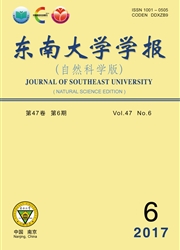

 中文摘要:
中文摘要:
为了提高大规模MIMO系统的分集增益、降低译码复杂度,构建了一种码率为1的满分集贝尔实验室垂直分层空时码,并采用最大比合并算法(MRC)检测接收信号.分别计算了MRC算法的平均输出信干噪比(SINR)和传统迫零算法(ZF)的平均信噪比(SNR),分析了性能相等时应满足的条件,并且比较了2种算法的计算复杂度和BER性能.结果表明,当BER=10-5,收发天线数为400和40、调制方式分别为BPSK和QPSK时,最大比合并算法的BER性能较迫零算法分别存在0.4和0.3 d B的增益.采用所提算法对接收信号进行检测,不但能够降低系统的计算复杂度,而且能保证系统的误比特率性能.
 英文摘要:
英文摘要:
To improve the diversity gain of the massive multiple-input multiple-output( MIMO) system and reduce the decoding complexity,a kind of rate one vertical bell laboratories layered space time( VBLAST) code with full diversity is designed,and the received signals are detected by a lowcomplexity algorithm,named maximum ratio combining( MRC) algorithm. The average output signal-to-interference-noise ratio( SINR) of this algorithm and the average output signal-to-noise ratio( SNR) of the traditional zero-forcing( ZF) algorithm are calculated,respectively. The conditions of equal performance are analyzed. The computational complexity and the bit error rate performance of these two algorithms are compared. The results showthat the MRC algorithm can provide a gain of 0. 4 and 0. 3 d B than the ZF algorithm when the bit error rate( BER) is 10-5and the numbers of the transmit antennas are 400 and 40 for binary-phase shift keying( BPSK) and quadrature-phase shift keying( QPSK),respectively. The MRC algorithm can decrease the computational complexity and ensure the bit error rate performance in the massive MIMO system.
 同期刊论文项目
同期刊论文项目
 同项目期刊论文
同项目期刊论文
 期刊信息
期刊信息
